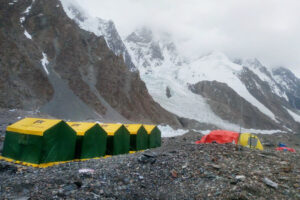Seasoned climbers say the less time you remain at high altitude, the better. That’s why some of the strongest climbers stress swift ascents and descents, even sometimes at the expense of safety. In addition to fitness, non-mechanical options for a speedy descent include skis and, fastest of all, paragliders.
On July 2, Boris Langestein of France skied down from 50m below the top of Nanga Parbat, after bagging the year’s first summit. A day later, the three Death Zone Freeriders, Vitaly Lazo, Anton Pugovkin and Cala Cimenti, summited as well. Two of them, Lazo and Cimenti, partly skied down. The first complete ski descent is still available, despite the historic efforts of such first-class ski mountaineers as Luis Stitzinger and especially Hans Kammerlander. He skied all the way down from just 100m below the summit in 1990.

Uncertainty shrouded the Death Zone Freeriders’ own descent, because they took much longer to reach Camp 4 than others on foot. Here is Cimenti’s account of that day:
The three were perched at 8,080m, just below the summit of Nanga Parbat. The sun was about to set, and a steep couloir yawned under their boots. Anton Pugovkin had left his skis about 200m below.
Vitaly Lazo suggested that they remove their skis in favor of crampons. Cimenti says that there was no way he would abort his ski attempt, after all the struggles and sacrifices it took to get there. “I cut down rightwards, then took a left turn, and felt there’s something wrong,” he recalled.

Anton Pugovkin, who decided not to ski, descended Nanga Parbat in the early evening.
It turned out that the residual glue from the climbing skins that he had used to schuss most of the way up the mountain had caused big globs of snow to adhere to the bottom of his skis. He needed nearly an hour to clean them, after which it was totally dark.
He and Lazo skied down the couloir with headlamps. For Cimenti, it was a moment of joy and freedom, doing “the most important thing in my life.” Eventually, Lazo took off his skis, and Cimenti did the same when they finally joined Pugovkin. They reached Camp 4 very late and sent a all-OK message to their families, who had become increasingly alarmed.
Read the full report from Cimenti (in Italian) here.
https://www.youtube.com/watch?time_continue=3&v=320JJrdXZxw
Flying from Broad Peak
On Broad Peak, Max Berger managed to paraglide from Camp 3 after summiting. Flying conditions on top were “far from ideal,” he admitted. The following day, however, a perfect morning dawned over Camp 3, so he flew from there to Base Camp. Berger is now heading for the Abruzzi Spur route on K2. Weather permitting, he will jump from the 8,611m summit.
Paragliding from those lofty altitudes is trickier than normal because of the thin air. ExWeb spoke to Antoine Girard, who soared over Broad Peak three years ago, reaching 8,157m. In 2009, he also jumped from Broad Peak’s C3. “At high altitude, we have to run faster or need more wind for take off,” he explains. “Everything else is the same.”

Max Berger after landing at Broad Peak’s Base Camp. Photo: Boa Fit Systems






